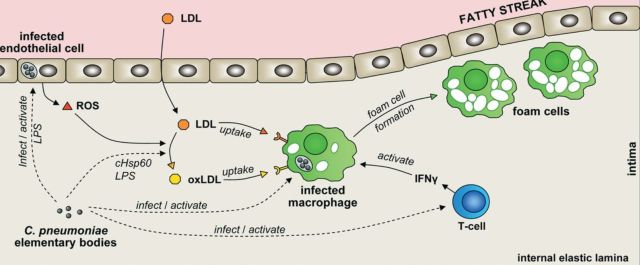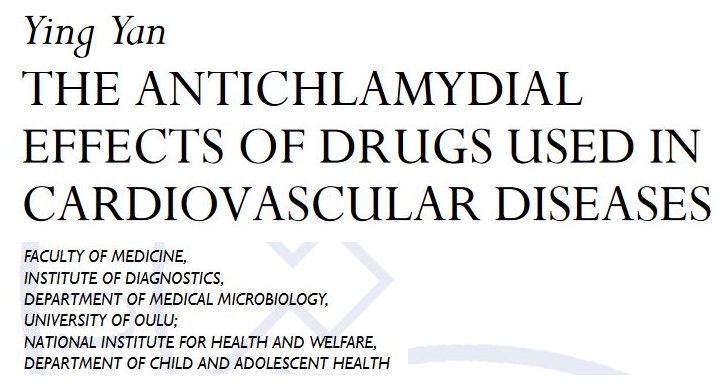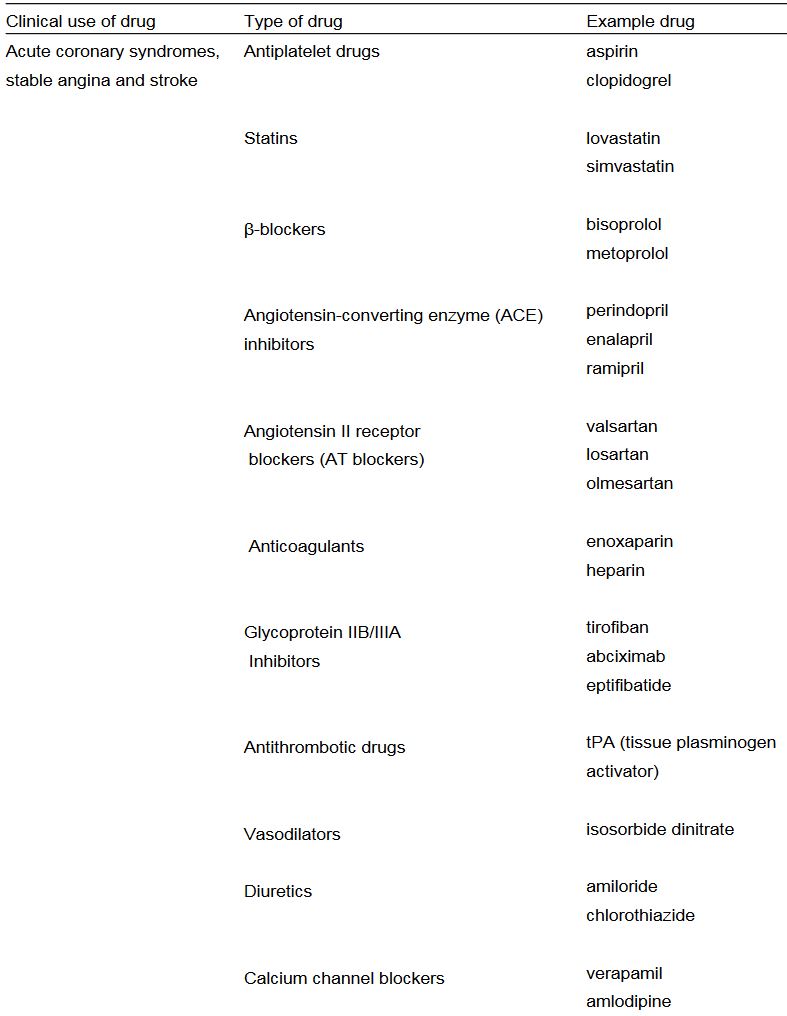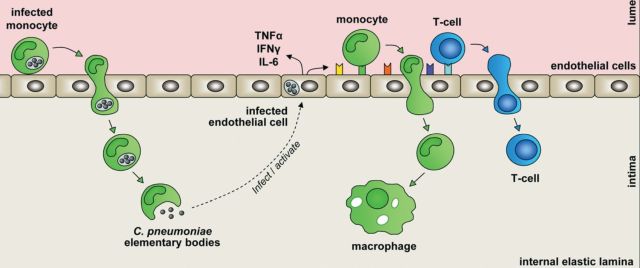nemoci-sympt/BAKTERIALNI-INFEKCE/chlamydie/symptomy-a-asociovana-onemocneni/ateroskleroza
Atherosclerosis
- High cholesterol levels
- Are a risk factor for atherosclerosis
- But are no causative agent thereof [68]
Chronic inflammatory process
- "Since 1981, it is recognized that atherosclerosis is an inflammatory disease (Ross, 1999, Engl. J. Med. 340: 115-126) and not a degenerative process as claimed in the past. It can thus be treated and cured or stopped." [68]
- Mainly a lipid infiltration process after a proteolytic and oxidative aggression of the arterial walls [68]
- In response to a variety of injuries:
- Helicobacter pylori [1]
- Cytomegalovirus
- Herpes simplex virus
- Chlamydia pneumoniae
- Strongest evidence for an association to infectious agent and atherosclerosis is that for Chlamydia (Chlamydophila) pneumoniae
- Seroepidemiologically 50 - 80% of the adult population has had prior exposure to this pathogen [1]
Chlamydia pneumoniae infekce a šíření do cévních stěn
- Preferentially infects respiratory tract epithelial cells
- May disseminate from this site, probably via circulating leukocytes
- Monocytes
- Lymphocytes [2]
Starting an atherosclerotic plaque
- Infected endothelial and smooth muscle cells, fibroblasts by intracellular parasites
- Sufficient for the excitation of the circulating monocytes by bacterial toxins
Zvýšená epitelální propustnost
- Reakce na infekci epitelu je na počátku
- Before the lesions of atherosclerosis are formed, the permeability of endothelial intima is increased to:
- Lipoproteins
- Prostacyclin
- Platelet-derived growth factor
- Angiotensin II andendothelin
- Up-regulated
- Leukocyte adhesion molecules
- L-selectin [99]
- Integrins
- Platelet-endothelial-cell adhesion molecule 1
- Endothelial adhesion molecules
- E-selectin, P-selectin, intercellular adhesionmolecule 1
- Vascular-cell adhesion molecule 1
- Edematous arterial reactions
- Considered as initial stages of atherosclerosis [68]
A co je migrena ? Perivaskulární infiltrát a arteriální edem jen tak z ničeho nic ?
A co je aura - příznaky, které mohou být změněny s tranzitorní ischemií urč. částí mozku a někdy mohou i plynule přejít v CMP ?
Je to cévní reaktivita na které se podílí receptory pro serotonin aj. A že zrovna metabolismus L-tryptofanu je pro metabolismus Chlamydií tak kritický...
Já si už delší dobu myslím, že migréna je jakási cévní reakce spojená s nějakým přechodným lokálním zánětem a prosakem. Podobně jako jsou záněty žil např. v nohou, kdy člověk cítí bolest v průběhu žíly. Čím více si o tom čtu, tím více mě vzrušuje otázka, zda již někdo zkoumal nějakou souvislost mezi C.pneumonia a migrénami.
Protein and lipid cellular debris form a gruel in arterial walls
- Rich in cholesterol and cholesterol esters [68]
- Then invaded by conjunctive fibres and non oriented muscular fibres [68]
- Atherosclerotic plaque is fragile and tends to break [68]
- Progressively transformed into fatty streaks
- Developing into an atherosclerotic plaque mainly responsible
- NADPH-oxidase
- Metalloproteinases [68]
- Amplification starts between the white cells
- Excite each other by uncontrolled secretion of cytokines [68]
- Soluble factors from endothelial cells infected with C. pneumoniae have recently been shown to stimulate smooth muscle cell proliferation [119]
Dyslipidemie a C. pneumonia infekce
- Acute pneumonia caused by C. pneumoniae than in pneumonia caused by viruses and other bacteria [14]
- In chronic C. pneumoniae infection (persistent IgG and IgA over 3 years) than in seronegative [14]
- An increase in serum triacylglycerols (triglycerides)
- Decrease in HDL (high-density lipoproteins) [14]
- C.p. infekce induces the production of:
- TNF-alfa (tumour necrosis factor-alpha)
- IL (interleukin)-1ß
- IL-6
- IFN-gamma [14]
- Jsou signály pro zvýšenou endogenní sytézu cholesterolu v játrech !
- Administration of TNF-alfa to rats
- Elevates both plasma triacylglycerol and cholesterol levels !!! [14]
- Hypercholesterolaemia has a significant suppressive effect on cellular immunity [14]
- Pre-existing hypercholesterolaemia could potentially increase the risk of developing a chronic C. pneumoniae infection [14]
- De novo hepatic fatty acid and triacylglycerol synthesis [14]
- Inhibition of adipose lipoprotein lipase activity [14]
- IL-1, IL-6 and IFN-gamma
- Can increase cholesterol synthesis and hepatic fatty acid synthesis [14]
- Inhibit adipose lipoprotein lipase activity [14]
- C. pneumoniae can induce macrophages to take native unmodified LDL
- Chlamydial LPS and cHsp60 can induce oxidation of LDL within the neointima
- Mechanism by which C.pneumoniae could enhance foam cell formation [99]
- LDL inhibit endothelial function by
- Down-regulation of endothelial NOS expression
- Decrease receptor-mediated oxide (NO) release
- Impair vascular relaxation and platelet egation
- Increase vascular smooth muscle proliferation
- Enhance leukocyte adhesion to the endothelium [99]
C.pneumonia a oxidace LDL
- C. pneumoniae exposure can induce
- Macrophages to take up increased amounts of native LDL and become foam cells
- Up-regulation of LDLrs [14]
- Chlamydial LPS (lipopolysaccharide) and cHsp60 (chlamydial heat-shock protein 60) can induce
- Oxidation of LDL within the neointima
- Enhance foam cell formation [14]

- Hsp60 C. pneumoniae navozuje formaci pěnových buněk indukcí oxidace nízkodenzitního lipoproteinu v makrofázích cévní stěny [121]
Pathological activation of blood white cells
- Plaque contains inflammatory infiltrates
- Leukocytes, monocytes and T cells
- Migrate into the wall [99]
- If excess LDL
- Infiltrates the artery
- Accumulates in the intima
- Fatty streaks initially consist of
- Lipid-laden monocytes macrophages (foam cells)
- T lymphocytes
- Later joined by various numbers of h-cells [99]
Monocytes
- Cross the vascular wall by diapedesis = makrofágy
- Rich in lysosomes and NADPH oxidase
- Proteolytic enzymes - metalloproteinases
- Form the proteic part of the gruel
- NADPH oxidase produces the superoxide anion
- Precursor of most of the activated oxygen species that are responsible for the oxidative attacks (Babior, 1999, Blood 93: 1464-76) [68]
Infikované s poruchou apoptózy ?
- Ingests by phagocytosis blood lipoproteins which have reached the intima by crossing the endothelium [68]
- Accumulate the main part of lipoprotein cholesterol and cholesterol esters
- Přeměna macrophages na pěnové buňky
- Ingested lipoproteins are oxidized
- Form the lipid part of the gruel [68]
- cytokiny
- TNF-alfa
- IL-l beta
- IL-8
- Attract
- Circulating monocytes
- Circulating polymorphonuclear neutrophils
- Monocytes are real «sanctuaries»
- Elementary bodies are sheltered from antibiotics and imunitní destrukcí [68]
Neutrophils
- Myeloperoxidase
- Transforms hydrogen peroxide into chlorinated derivatives highly destructive for tissues:
- Hypochlorous acid
- Chloramines
- Chlorine
CD4+ T cells
- T cells are activated and secrete Th1 cytokines
- Appear polyclonal
- Less diverse in the lesions of patients with unstable angina
- Plaque-derived T cells
- Can be stimulated by C pneumoniae
- = presence of pathogenspecific lymphocytes in vivo
cHsp60 Chlamydiální protein teplotního šoku a protilátky
- Stimulates macrophages to produce MMPs (matrix metalloproteinases)
- Weaken the plaque [14]
- Protilátkové odpovědi na chlamydiální Hsps60 u astmatu, aterosklerózy a akutní přední uveitidy
- Protilátky proti chlamydiálnímu Hsp60
- Zkřížená reakce s lidským Hsp60
- V makrofázích aterosklerotických plaků byl vedle chlamydiální Hsp60 zjištěn i humánní Hsp60
- Obdobná zkřížená reakce je známá u některých bakterií zubního plaku při paradentóze
- Také asociována s progresí aterosklerózy
Hladké svalové buňky a C. pneumonia
- SMC proliferation and migration from the media to the intima
- Macrophages are stimulated by cHsp60
- Secrete MMPs
- Degrade the internal elastic lamina
- Cytokines and growth factors secreted [14]
- Infected ECs secrete soluble factors
- PDGF-B (platelet derived growth factor B)
- HB-EGF (heparin-binding epidermal-growth-factor-like growth factor) [14]
- OxLDL
- SMCs secrete
- Extracellular matrix molecules
- Fibrin
- Proteoglycans
- Collagen [14]
Prokoagulační stav a C. pneumonia
- Up-regulation of tissue factor and PAI-1 (plasminogen activator inhibitor-1) by infected ECs and SMCs
- Increases the likelihood of thrombosis in the event of plaque rupture [14]
- A number of reports have described an independent association between
- C. pneumoniae seropositivity
- Raised fibrinogen levels [14]
- Increased C. pneumoniae IgA antibody titer
- Associated independently with elevated concentrations of fibrinogen
- Related to unstable coronary artery disease [99]
- C. pneumoniae
- Can stimulate platelet activation and aggregation
- Enhancing thrombotic risk in acute vascular syndromes
- Different from that of collagen and thrombin
- May not be inhibited by the COX antagonist aspirin
- 12-lipoxygenase inhibitors may be rational therapies to reduce thrombotic risk in atherosclerosis patients with persistent C. pneumoniae infection [14]
Ischemická choroba DK
- Strong association between Chlamydia pneumoniae and atherosclerosis
- Antibiotic therapy in peripheral artery disease decreased need for revascularization and improved walking ability
- Phase-III trial to assess the effect of a potent anti-Chlamydial agent, rifalazil
- 297 Patients with intermittent claudication secondary to peripheral artery disease from 3 countries followed up for 1 year [116]
- Seropositive for C pneumoniae
- To 25 mg rifalazil once weekly for 8 weeks
- Placebo [116]
- Rezults:
- Improved their peak walking times by 23% (95% confidence interval, 15 to 31) from baseline to day 180
- Placebo group improved by 18% (95% confidence interval, 11 to 26; P=0.38) [116]
- Rifalazil did not improve exercise performance or quality of life [116]
Detekce Chl.pn. u karidovaskulárních nemocí
Společné projevy infekce C.p. a aterosklerozy
- + CRP
- + leukocytes
- + cytokines
- + immune complexes
- + antigenic mimicry of Omp2
- + endotoxin
- + Hsp 60 C.p. [99]
- + cholesterol
- Detection of C. pneumoniae antigen in blood
- Obtained from patients with or without coronary artery disease (CAD) [2]
- C. pneumoniae satisfies most, but not all, of Hill's criteria
- As a causal factor in atherosclerosis [14]
- Known risk factors are felt to account for approximately 50-70% of the pathogenesis or cardiovascular diseases
- 1986 - first indication that C. pneumoniae has an association with atherosclerosis and coronary heart disease
- Seroepidemiology, immunohistochemistry, PCR, electron microscopy and tissue culture
- C. pneumoniae DNA
- Recovered from CD3+ peripheral blood leukocytes from patients with CAD
- Peripheral blood leukocytes, particularly lymphocytes
- May be host cells for C. pneumoniae
- May play a critical role in the development of atherosclerosis [2]
- Children with persistent IgG and/or IgA seropositivity to C. pneumoniae
- Significantly increased aortic intima-media thickness (measured by ultrasound) at 11 years of age
- Compared with C. pneumoniae-seronegative children and children who had been transiently C. pneumoniae seropositive
- Evidence of a possible role of persistent C. pneumoniae infection in promoting early atherosclerosis [14]
- Review of 43 histopathological studies concluded that C. pneumoniae could be detected
- In 46% of atheromatous arteries
- <1% of healthy arteries [14]
- C. pneumoniae could be detected in 79% of coronary artery atheromas
- Only in 4% of coronary arteries diseased as a result of chronic cardiac transplant rejection [14]
- The New Zealand White rabbit
- Does not develop atherosclerosis unless fed a high-cholesterol (atherogenic) diet
- C. pneumoniae inoculation of rabbits, even fed a normal diet
- Produced fatty streak lesions 1 week after infection
- Grade III atherosclerotic lesions within 2 weeks [14]
- no lesions were observed in sham-inoculated controls [14]
- Direct experimental evidence that C. pneumoniae infection was sufficient to induce atherosclerosis
- It was possible to isolate viable C. pneumoniae from grade III atherosclerotic lesions [14]
- Mouse
- Active C. pneumoniae infection must occur in the setting of hypercholesterolaemia
- To influence the progression of atherosclerosis [14]
- Humans
- Caution in translating these results to humans because of potential species differences [14]
C.p. a asociované kardiovaskulární choroby s C.pneumonia
- Coronary artery disease
- Severe essential hypertension
- Coronary atheromas
- Acute ischaemic stroke
- Myocardial infarction
- Cerebrovascular accidents [99]
- AIM [121]
- Cévní mozková příhoda [121]
- Tranzitorní ischemická ataka (TIA) [121]
- Aneurysma abdominální aorty (AAA) [121]
- Peripheral artery occlusive disease (PAOD) [144]
Aneurysma aorty
- C pneumoniae was found in 11/25 aortas, 5/9 iliac arteries, 2/5 femoral arteries, and 1/2 iliac veins, by PCR in AAA specimens
- Seen in vascular tissue from 3/6 "ostensibly normal" liver transplant donors, which showed some atherosclerotic changes [142]
- G Ong, BJ Thomas, AO Mansfield, BR Davidson, D Taylor-Robinson. J Clin Pathol 1996 Feb;49(2):102-106). Ong - J Clin Pathol 1996 abstract / PubMed [142]
ATB terapie a kardiovaskulární onemocnění
- Susceptibility of C. pneumoniae to antibiotics after invasion of monocytes and lymphocytes is not well known
- Study showed that antibiotics do not inhibit chlamydial growth within monocytes [2]
- C. pneumoniae TW183
- Azithromycin (AZM)
- clarithromycin (CLR)
- Tosufloxacin (TFLX)
- Minocycline (MINO)
- All antibiotics used were very effective against C. pneumoniae growth in HEp-2 epithelial cells
- Bacterial growth in monocytes (THP-1)
- Markedly suppressed by either AZM or TFLX at the same concentrations
- CLR and MINO did not show any inhibitory activity against chlamydial growth in monocytes
- C. pneumoniae growth in T lymphocytes (Molt 4)
- Inhibited by TFLX and CLR, with MICs comparable to those in HEp-2 cells
- But not by AZM or MINO
- All antibiotics tested failed to inhibit the growth of C. pneumoniae in B lymphocytes (P3HR1)
- Even at a concentration as high as 32 µg/ml - more than 10 times the concentration in serum !!! [2]
- P3HR1 cells supported more bacterial growth than Molt 4 cells [2]
- Susceptibility of C. pneumoniae to antibiotics was dependent on host cells [2]
- Different levels of AZM uptake by cultured cells
- Epithelial cells, neutrophils, and macrophages, have been demonstrated [2]
- Small-scale studies indicated that antibiotic treatment may prevent adverse cardiovascular events
- Large clinical trials failed to demonstrate any effect
- Two studie, antibiotics on the rate of expansion of abdominal aortic aneurysms
- One small study found a non-significant decrease in this rate with doxycycline treatment
- Other found a similar difference with roxithromycin treatment that did reach statistical significance
- C. pneumoniae is highly likely to be a modifiable risk factor that may be a target of future therapies
- Large study on antimicrobial treatment in CAD patients
- AZT treatment had no significant effect on clinical events [2]
- Pathogen may not be eliminated from its host by standard antichlamydial treatments [2]
- Antibiotics, including AZM and CLR, probably do not eliminate C. pneumoniae from HEp-2 cells
- Its persistent state in these cells
- Nonreplicating state of this pathogen is also a possible reason for the resistance [2]
- C.p. stimulates
- Secretion of pro-inflammatory cytokines (e.g. TNF-?, IFN-? and IL-6)
- Leukocyte adhesion molecules (e.g. VCAM-1, ICAM-1 and E-selectin) [14]
- 60 male post-MI patients, persistently seropositive for C. pneumoniae (IgG?1:64 on two occasions 3 months apart)
- Randomized to receive a 3- or 6-day course of 500 mg/day azithromycin or placebo
- After 18 months follow-up
- OR for cardiovascular events ( MI, unstable angina, revascularization or cardiovascular death)
- 5-fold lower in patients receiving antibiotic treatment compared with placebo
- OR, 0.2 (95% confidence interval, 0.05–0.8); P=0.03) [14]
- ROXIS (Roxithromycin in Ischemic Syndromes) study randomized 202 patients with ACS
- Receive a 30-day course of 150 mg of roxithromycin or placebo twice a day
- After 1 month follow-up
- Significant reduction in adverse cardiovascular events (severe recurrent angina, MI and ischaemic death) in the ATB group
- Two out of 102 patients compared with nine out of 100
- At 6 months - the reduction was no longer significant [14]
Evidentně také krátká a nedostatečná forma terapie chronické infekce ve tkáních
- Large-scale trial CLARICOR study
- 4373 stable CAD patients were randomized
- 2-week course of 500 mg of clarithromycin or placebo/day
- After 3-years follow-up
- Cardiovascular mortality was significantly higher in those who had received antibiotic treatment !!! [14]
- Subinhibitory concentrations of antibiotics
- Able to induce the persistent form of C. pneumoniae, which is more resistant to antibiotics [14]
- Animal studies indicate that antibiotics are effective only if treatment is started soon after C. pneumoniae infection [14]
- WIZARD studie
- Tříměsíční léčba azithromycinem podávaným jednou týdně
- Nepřináší efekt v léčbě koronární srdeční nemoci [121]
- ACES studie
- Azithromycin dávkovaný 1krát týdně po dobu 1 roku
- Neovlivnil riziko srdeční příhody u nemocných se stabilní koronární nemocí [121]
- PROVE-IT studie
- Prolongované (10 dní v měsíci) podání gatifloxacinu po dobu průměrně 2 let
- Signifikantní ochrana před koronární příhodou nalezena nebyla [121]
- GATIFLOXACIN
- Compare gatifloxacin 10 days each month x placebo for the secondary prevention of cardiovascular events
- Side effects:
- Diarrhea, nausea, vomiting, new-onset diabetes, hyperglycemia, and hypoglycemia
- Associated with torsades de pointes and other ventricular arrhythmias
- And sudden death differ between the two groups
- Gatifloxacin provided no significant benefit in terms of any of the predefined primary or secondary end points
- Gatifloxacin group increased in
- Death from all causes
- Death from coronary artery disease (hazard ratio, 1.55)
- Richard Frothingham, M.D., Veterans Affairs Medical Center, Durham, NC 27705, richard.frothingham@duke.edu
Léky účinné ve pomalení progrese aterosklerózy = potlačují progresi Chlamydia pneumonia
Non-selective cyclooxygenase (COX) inhibitor aspirin
Heparin-like antithrombin drugs
- Can reduce the risk of blood clots
Calcium-channel blockers
- Potencůjí antichlam. účinek falvonoidů
- Commonly used to reduce the work load of heart by relaxing the arteries
Antiproliferation activity of rapamycin
- Snižuje infektivitu Ch.p.
- Useful in eluting stents for resisting in-stent restenosis
Patentovaný návod
US 6,048, 903
- Stilbene-type phyto-alexin resveratrol
- Treat inflammatory phenomena
- As well as its analogues (hydroxylated and methoxylated analogues of resveratrol)
- Useful to slow down or inhibit the development of several forms of cancers, such as colorectal cancer
- Anti-oxidant
- Trans- resveratrol
- Reduce the level of light density lipoproteins (LDL)
US 6,211,247
- Preventing restenosis
- Accelerated form of atherosclerosis of non- infectious origin
- Addition of cis- resveratrol and/or trans-resveratrol
WO 02/32410
- Treating inflammatory respiratory disorders - combination:
- resveratrol
- Glucocorticoids
- Prednisolone and dexamethasone [68]


Dialysis
- Serum titre of anti-C. pneumoniae antibodies is directly related to the severity of carotid atherosclerosis both in patients with chronic renal diseases [8] and in dialysis patients5., 9.. Furthermore, a retrospective cohort study of small dimensions has recently reported that the presence of anti-C. pneumoniae antibodies predicts survival in patients treated by peritoneal dialysis [170]
Infarkt myokardu
- Význam zánětu a zvýšené odpovědi imunitního systému aktivovaného v průběhu chronické infekce C. pneumoniae je diskutován v souvislosti s
- Aterosklerózou
- Akutním infarktem myokardu (AIM)
- Ischemickou chorobou srdeční
- První výsledky spojující C. pneumoniae s koronární srdeční nemocí a AIM publikoval Saikku již v roce 1988 [121]
Kalcifikace tepen
- In atherosclerotic plaques, calcium is found as hydroxyapatite, the form found also in the bone.15,16 Further similarities with calcium and bone metabolism are that atherosclerotic calcification is characterized by local expression of osteopontin, osteonectin, osteocalcin, and bone morphogenetic protein type 2 and the presence of "calcifying vascular cells."16-21 However, it is not known whether infectious agents play any role in the calcification process of the arteries. [171]
- Large, population-based study were that the presence of chlamydia antibodies was associated in a dose-response fashion with the degree of intimal artery calcification and that this association was not explained by other cardiovascular risk factors. These findings suggest, but do not prove, that Chlamydia may play a fundamental role in the pathogenesis of calcification of atherosclerotic lesions. [171]
- Chlamydia antibodies were associated with intimal artery calcifications and not with medial artery calcifications. [171]
- Smoking is strongly associated with arterial calcification, and as smokers more frequently have Chlamydia antibodies [171]
